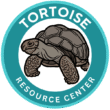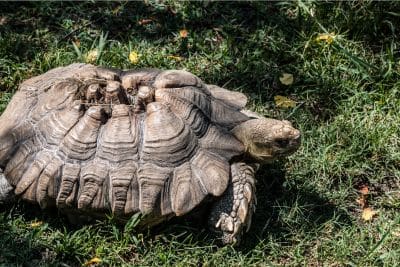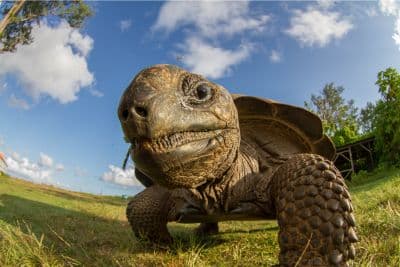The leopard tortoise (Stigmochelys pardalis), native to South Africa, is one of the largest species of tortoise. It gets its name from the spotted pattern on its shell that resembles a leopard. However, a common health condition these tortoises face is a shell deformity known as pyramiding.
In this guide, I’ll be explaining everything you need to know about what causes Leopard tortoise pyramiding, how it can be prevented and what to do if you notice any symptoms.
Understanding Pyramiding
Pyramiding is a common issue with captive tortoises, which is unfortunately not reversible. However, if it’s caught very early on, it can be prevented. In general, wild tortoises seldom suffer from pyramiding as it’s normally a result of inadequate husbandry.
There are numerous challenges that come with pyramiding. Firstly, it causes irreversible damage to the outer surface of the shell, and although subsequent growth may smooth out, the previous, existing ‘pyramids’ will remain. Additionally, pyramiding can affect a tortoise’s long-term mobility and organ function.
What is Pyramiding?
Tortoise shells are covered with bony, external plates called scutes. Pyramiding is the result of excess upward growth of the scutes, resulting in each segment taking on a pyramid-like shape.
During normal growth, scutes develop horizontally. However, in a tortoise that is developing pyramiding, scutes grow in a vertical direction.
A normal leopard tortoise shell will have smooth scutes, evenly distributed growth rings and a flat shell surface. Pyramiding shells will have raised scutes, irregular, pronounced growth rings and a bumpy, uneven shell surface.
Signs of pyramiding to watch out for include bumps on the shell, scutes that are lifting or separating and shell discoloration.
Causes
Improper diet is one of the main causes of pyramiding. In particular, overfeeding often results in an excess number of vitamins, minerals, protein and fat in the diet, with excess protein specifically causing a tortoise’s shell to grow too rapidly, leading to pyramiding.
In the wild, leopard tortoises live on a mainly herbivorous diet, obtaining most of their protein through the occasional invertebrate, so it’s important your captive tortoises’ diet reflects the food they would obtain naturally.
Additionally, both calcium and phosphorus are necessary to build healthy bone tissue and maintain shell strength and structure. However, an imbalance or lack of calcium can lead to issues with shell development, potentially causing pyramiding.
According to the British Chelonia Group, tortoises require a diet with a calcium : phosphorus ratio no greater than 2:1. This is because high doses of phosphorus can prevent them from effectively absorbing much needed calcium.
Much of their diet consists of fibrous leaves, grass and hay that contain higher proportions of phosphorus compared to calcium. So to counteract the negative effects of phosphorus, pet tortoises benefit from calcium supplementation, as much variety in their diet as possible and plenty of Vitamin D3 to help with calcium absorption.
Another factor that is known to affect a pet leopard tortoise’s overall health and shell development is lack of adequate exercise. In the wild, tortoises need to forage for food, often walking relatively long distances in search of something to eat.
Conversely, pet tortoises are most often restricted by the size of their enclosure, plus, they are literally handed food on a plate! With less need or requirement to move, captive tortoises are more prone to shell abnormalities such as pyramiding.
As an owner, it’s possible to mitigate these shell problems by hiding food, encouraging exercise by placing dirt mounds, rocks and hiding places in the enclosure, and feeding less often and for a definitive period of time (say, 20-23 minutes at each feed).
When it comes to tortoise shell pyramiding, genetics can also play a role. Some leopard tortoises may be more genetically predisposed to this condition than others.
Additionally, environmental influences such as temperature, humidity, lighting and UV exposure can impact a tortoise’s shell development. Indeed, humidity levels are regarded as one of the key causes of pyramiding. For example, low humidity environments can dry out the shell, causing pyramiding.
Moreover, tortoises like other reptiles require sufficient UVB to synthesize vitamin D3, which is essential for shell and bone development. Vitamin D3 deficiency can lead to metabolic bone disease (MBD), as well as pyramiding. Additionally, high temperatures can lead both to dehydration and increased growth in juveniles, both of which are precursors for pyramiding.
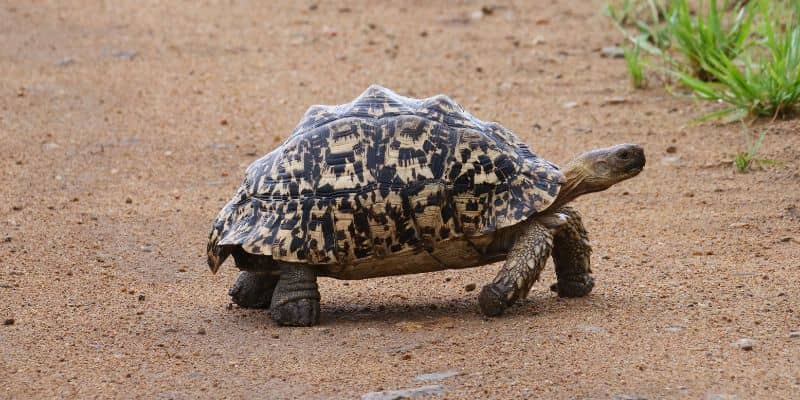
Pyramiding Prevention
Although there is still a lot to learn about pyramiding, both dietary and environmental factors are found to be most responsible. Additionally, it’s almost impossible for pyramiding to be reversed. Therefore, emphasis needs to be on prevention. There are lots of ways you can help prevent pyramiding in your Leopard tortoise, as follows:
Ensure proper humidity levels. Leopard tortoises require humidity levels of between 40% and 60% so it’s important to use moisture-retaining substrate materials and spray the enclosure with a fine mist of water regularly.
Invest in a hygrometer to keep track of humidity levels within the enclosure and avoid misting at night.
Keep your tortoise hydrated by providing them with access to a shallow dish of water for them to bathe. Tortoises can absorb water through their skin and shell, so this will help keep them hydrated.
Ensure a proper diet consisting of a high-fiber, low fat, low protein diet. Leopards need 90% fibrous grasses and hay and 10% leafy greens and vegetables. Offer as much variety as possible to ensure they get a good mix of nutrients.
Additionally, I recommend calcium supplements that you can sprinkle evenly over your tortoise’s food.
Maintain year-round UVB. For tortoises housed outside, the sun is an excellent source of UVB light. However, for tortoises housed inside, you will need to install UVB lamps. This is so they can synthesize vitamin D3, which in turn allows them to absorb calcium.
These lamps need to be switched on for 8-10 hours a day in the winter and 12 hours a day in the summer, to mimic the natural pattern of the sun. UVB light enables tortoises to synthesize vitamin D3, which in turn allows them to absorb calcium.
When the outside weather allows, I recommend taking your tortoise outside to expose them to natural sunlight and UVB rays.
Provide ample living space. Make sure your tortoise has an enclosure that is large enough for them to move around and get enough exercise. Incorporating accessories and decorations into your tortoise’s habitat to encourage them to get exercise and explore.
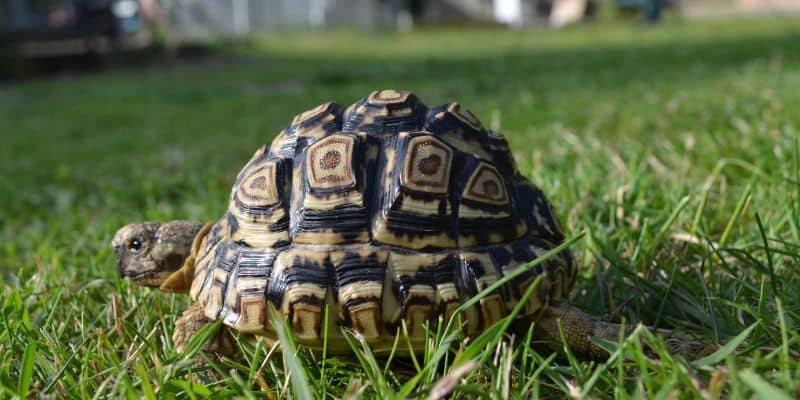
Identifying Pyramiding
Tortoise pyramiding is easy to identify. It’s characterized by the build-up of keratin in the scutes, causing each segment to resemble a ‘pyramid’.
Whilst the shape of the scutes provide the most obvious sign of pyramiding, the costals which lie on either side above the ribs can also be affected. The signs can vary from mild to extreme, although the problem can go deeper than just a lumpy shell.
Whilst pyramiding itself is not painful, it can lead to other health concerns. Shell deformities can interfere with normal lung function and cause female tortoises to have issues laying eggs.
Moreover, pyramiding can affect mobility by causing the legs to become weak and move in abnormal positions. This results in arthritis and overgrown toenails. In more extreme conditions, pyramiding can cause paralysis due to changes around the spinal cord. If left untreated, it can lead to an early death.
Unfortunately, treating pyramiding is much harder, if not impossible. Scutes that already exhibit pyramiding cannot be undone. However, if caught early enough, further pyramiding can be prevented, and the shell can assume a normal shape.
Adjusting the environmental conditions for your tortoise will ensure new shell growth develops in a normal, horizontal direction.
Early Signs and Symptoms
Tortoise shell pyramiding is most likely to occur during early growth stages when they are young and developing. Hence, it’s imperative young tortoises receive the correct care and environmental conditions as hatchlings.
Early signs and symptoms of pyramiding you should keep an eye out for are bumpy or raised textures of the shell, specifically around the scutes. If left untreated, this uneven shell will soon show extreme pyramiding, leading to a cascade of complications for your tortoise.
Are You Starving Your Tortoise?
Save 10% on premium tortoise food and supplements from Tortoise Resource Center on Amazon now using code BUYNOWGET10
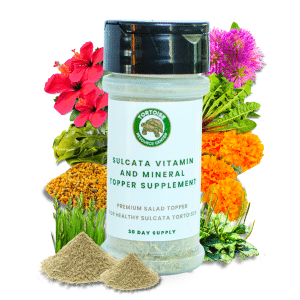
Sulcata Vitamin & Mineral Topper Supplement
30-Day Supply | 2 oz (56 g)
$24.99
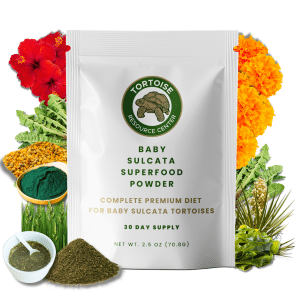
Baby Sulcata Tortoise Superfood Powder
30-Day Supply | 2.5 oz (70.8 g) Bag
$24.99
Treatment Options
It is not possible to reverse what has already pyramided. However, if you have caught it in the early stages whilst your tortoise is still young, you can ensure new growth develops smoothly and normally. This means any previous pyramiding will look less prominent when they are an adult.
If you notice pyramiding appearing, the best course of action is to check how you are caring for your tortoise. Here are some guidelines on basic husbandry requirements for adult Leopard tortoises:
| Enclosure Dimensions | Tortoise table or enclosure measuring 8ft (L) x 4ft (W) x 1.5ft (H) | Leopard tortoises need plenty of exercise and space for hiding spots and exploring. |
| Substrate | 50 / 50 mix of organic soil and cypress mulch or coco coir at a depth of at least 6 inches. | Use a combo that is well draining but retains some moisture to help with humidity.Spot clean daily to keep it clean and free from mold or bacteria buildup. |
| Humidity | Use a hydrometer to maintain 40%-60% humidity. Ensure there is adequate ventilation to avoid mold and bacteria that can cause pyramiding and respiratory problems. | For hatchlings and young tortoises, increase to 60% to 70%) to prevent prevent early pyramiding of the shell. |
| Basking Temperature | 90°F and 95°F. Position enclosure in a sunny spot outdoors and provide shade or use a basking light or heat lamp to maintain these temperatures indoors. Monitor temperatures regularly with a thermometer. | Only house outdoors if the climate temperature is consistent year-round or bring indoors if winter temperatures are lower. |
| Cool Zone Temperature | 75°F to 80°F. Follow instructions as per basking temperature monitoring and maintenance. | As above. |
| Nighttime Temperature | 70°F and 75°F | As above. |
| Light Requirements | UVB light requirements: 8-10 hrs per day in winter and 12 in summer. | Fit light 12-14 inches above the tortoise’s shell and 2-4 inches lower if you have a mesh cover. Use a Solar meter to determine a UVI of 4.0 to 6.0. |
| Diet | 90% grass and hay and 10% weeds, leafy greens and vegetables.Sprinkle food with calcium powder evenly distributed. | Offer 4-5 different types at every meal. Feed hatchlings daily for 20 minutes and adults every other day for 20-30 minutes. Remove food after this time to avoid overfeeding. |
I recommend taking your leopard tortoise for annual health check-ups. However, if you are concerned your tortoise is beginning to show signs of pyramiding, I recommend seeking the advice of a veterinary specialist as soon as possible.
Catching the issue at an early stage is the best way to combat this disfiguring condition. A veterinarian can quickly identify the cause of pyramiding and offer management advice to rectify and prevent further cases.
Citations
- Arizona Exotic Animal Hospital – pyramiding
- RVC – care
- PubMed – protein and humidity
- British Chelonia Group – Calcium to Phosphorus Ratio
